�
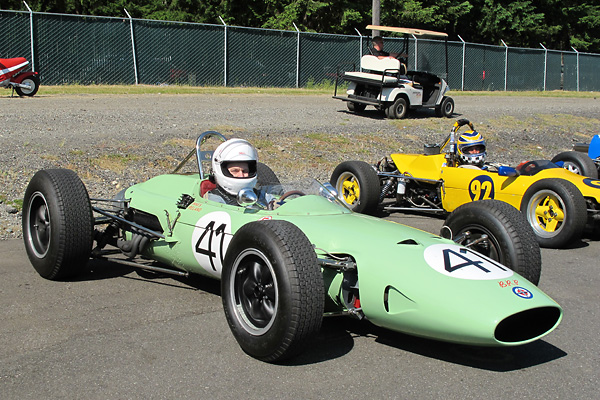
�
�
Kurt DelBene's 1964 B.R.P. (BRP-BRM) Grand Prix Race Car
� � Owner: Kurt DelBene� City: Redmond, Washington
� Chassis: BRP 64/2 replica
� Engine: BRM 1.5L V8
� Race prepared by: Byron Sanborn at Vintage Racing Motors�
�
The British Racing Partnership
��
After a Brands Hatch directors dinner meeting in November 1957, Stirling Moss' father Alfred and his manager�
Ken Gregory took an opportunity to talk shop. After many years of supporting Stirling's career, both men realized�
they'd soon have extra time on their hands because Stirling Moss had recently signed on to two premier works�
racing teams: Vanwall and Aston Martin. It occurred to the two men that they should establish their own racing�
team, as a partnership.�
�
Their idea was to purchase suitable cars and hire up-and-coming drivers. Perhaps Stirling would occasionally�
find time to drive for them between other commitments. It would be fun for all concerned. It might even�
make a little money. (The partners would be satisfied if it broke even.) These were sportsmen of the noblest�
type: plucky underdogs who occasionally punched well above their weight. Alfred Moss put up £2000�
and also offered his farm as a physical base. After just a couple months, Ken Gregory repaid £1000 pounds�
from entry fees, prize money and contengency fees (paid by fuel and tire suppliers, etc.). From then on they�
were equal partners. The new team was named British Racing Partnership.�
�
British Racing Partnership was active from 1958 through 1964. Over that period BRP entered 157 different�
cars in 275 different races, employing 32 different drivers including three world champions.�
�
BRP's first car was a Formula 2 Cooper, chassis number F2-10-58,�
with Climax FPF engine number 1041. Their first employee was their Chief Mechanic, Tony Robinson. Robinson�
had been with Stirling Moss and Ken Gregory since 1953. Stuart Lewis-Evans was the first of BRP's many drivers,�
and with him they were off to a promising start: a fine fourth place finish in the Lavant Cup. �
�
One of BRP's big challenges was that drivers tended to jump from car to car so frequently. (Like Stirling Moss,�
Lewis-Evans also drove for Vanwall and Aston Martin.) This affected scheduling and planning, sometimes in�
dramatic ways. Lewis-Evans died tragically before the end of the 1958 season of burns incurred after an accident�
in his Vanwall. BRP employed a number of outstanding drivers in those early years, only to lose them too soon. �
�
BRP entered Stirling Moss in two Grand Prix races during the 1959 season. The story behind those entries is an�
interesting digression: BRM was trying to recruit Stirling Moss to drive their P25 model car, but he wasn't comfortable�
with BRM's team management. Alfred Moss negotiated a deal where Stirling would drive a loaned BRM P25 but it�
would wear BRP livery and would be maintained and entered by BRP. Stirling Moss ended up suffering a�
disqualification at the French Grand Prix, but recovered to place second two weeks later at the British Grand Prix.�
A schedule conflict prevented Moss from driving the P25 at Berlin in the German Grand Prix, so Hans Herrmann�
drove it instead. Herrmann had a spectacular accident. (The BRM P25 had its rear brake installed on its propshaft�
where it was subject to an acute vibration, with an unfortunate result being that it severed a brake pipe and had a�
total brake failure.) The car was written off, which ended the agreement between BRM and BRP. The BRM P25�
was an exception to a rule though; generally, BRP was a loyal Cooper Car Company customer.�
�
1960 was arguably the most important year of British Racing Partnership history because it was the year that�
Yeoman Credit Finance bankrolled BRP's efforts. "Yeoman Credit Racing" was the first totally sponsor-funded�
team in the history of motor racing. No team had ever before been sponsored by an outside company.�
BRP was given a sum of £40,000 just to buy their equipment plus £20,000/year to operate the�
team. With that much invested, it seemed they could compete on an even footing with any of the works teams.�
There would still be great difficulties. The team suffered two tragic driver fatalities that year: Harry Schell at�
Silverstone and Chris Bristow at Spa. Yeoman Credit's sponsorship of BRP wasn't renewed. �
�
In 1961 BRP signed a major sponsorship agreement with United Dominions Trust, who among various holdings�
owned Laystall Engineering, the principle supplier of crankshafts to the British automotive and aviation industries.�
The name "BRP" was still used for the management company, but the team's race entries were filled out "UDT-Laystall�
Racing."�
�
The generous UDT sponsorship deal seemed threatening to BRP's rivals, who frankly feared a bidding war for top�
drivers. The works teams seemed to feel especially threatened, but they had a way to level things back out. They could�
decline to sell BRP competitive cars. So it was that when Ken Gregory sat down with his very close and long time�
friend Charlie Cooper to discuss BRP's needs for the new Grand Prix season, he was told Cooper's supply of�
gearboxes were already committed, and therefore Cooper wouldn't be able to supply BRP a single complete�
Formula One racecar until July. (Other teams, including Reg Parnell's, were already scheduled to be served first.)�
�
Ken Gregory did what he had to do; he turned to Colin Chapman for a supply of Lotus racecars. The timing�
is interesting. Chapman had just signed up driver Jim Clark, so perhaps he didn't feel BRP was such a danger�
after all. Chapman sold BRP a mixed bag of cars, and they fielded a diverse mix of drivers. The purchase included�
three Lotus 18 (Formula One) racecars,�
three Lotus 19s, and one Lotus Elite. (By swapping between Climax four cylinder engines, BRP was able to race�
the Lotus 19s in four different classes.) In 1961 Grand Prix championship races UDT-Laystall was represented by�
four different drivers from four nations. They had hoped that Cliff Allison would drive throughout the whole season,�
but he had a bad accident, and suitable replacement drivers had various schedule conflicts. Lucien Bianchi,�
Masten Gregory, and Henry Taylor also drove for BRP in 1961 championship series Formula One races.�
(Juan Manuel Bordeu practiced at the French Grand Prix, but didn't start the race.)�
Additionally, Stirling Moss, Jo Bonnier and Carl Hammarlund drove for BRP in non-championship Formula�
One races. Then there were the lesser formulae. It was a busy year with only occasional and moderate success.�
�
For 1962 the UDT-Laystall team was more focused. They committed to fielding just two Grand Prix drivers and to�
keeping each of them in a specific car for the entire Grand Prix season. (By and large this worked out, although BRP�
was obliged to use back-up cars occasionally.) UDT-Laystall's star driver would be Innes Ireland, who had recently�
been dropped hard by Colin Chapman. Their second car would be driven by American driver Masten Gregory.�
UDT-Laystall procured two new Lotus 24s for the season. Ireland's Lotus 24 was powered by a Coventry�
Climax V8, whereas Gregory's Lotus 24 car was powered by the newly introduced BRM V8.�
�
Despite focus, the 1962 season went horribly for UDT-Laystall. It started on the wrong foot, with Innes Ireland having�
an accident at Zandvoort in the first of nine championship races. He would fail to finish four others due to breakdowns.�
There were other highs and lows. Ireland arrived too late to qualify at London's Formula One (non-championship)�
Crystal Palace Trophy Race and was thus obliged to start at the back of the grid, yet he sling-shotted past the entire�
field to grab a magnificent victory. Ireland also demonstrated his quickness by qualifying third fastest at the British�
Grand Prix. (Ireland lost first and second gear in the lap from the pits to the starting line and thus drove the whole�
British Grand Prix without low gears. He finished the race fourteen laps behind his personal rival, Jim Clark.)�
Ireland's best 1962 championship series result was in the season's final race, the South African Grand Prix, where�
he finished fifth but not before being lapped by 1962 champion Graham Hill. At the end of 1962, UDT withdrew�
their sponsorship.�
�
�
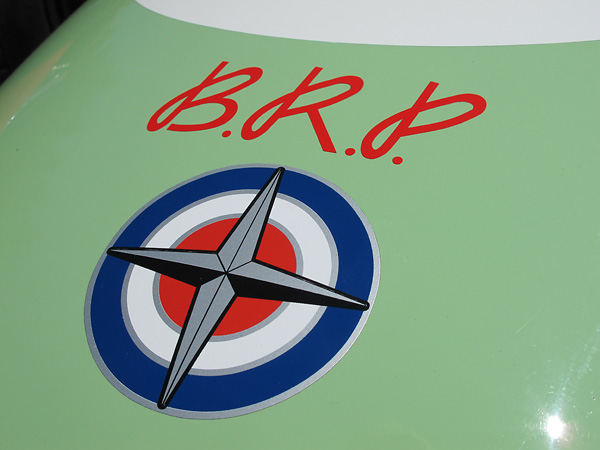
�
BRP-BRM
�
British Racing Partnership built their own racecars for the 1963 and 1964 Grand Prix seasons.
�
For these cars, BRP used British Racing Motors brand engines. BRM's logo is a stylized compass.
�
Please support the sponsoring companies who make www.BritishRaceCar.com possible, including:
� �
 �
�
�
�
Origin of the BRP-BRM Design: a racecar for the monocoque era.
��
BRM, Cooper and Lotus had obvious conflicts of interest. Each of these companies sold racecars to outside�
customers and then raced against them with their own works racing teams. Inevitably, this situation led to difficulties.�
At the start of the 1962 season, Colin Chapman aggressively promoted the Lotus 24 as a brand new�
design, without telling his customers it would be obsolete by the second round of the Grand Prix championship.�
The Lotus 24 debuted at the non-championship1962 Pau Grand Prix on April 23rd, and the Lotus 25 debuted�
at the Dutch Grand Prix on May 20. When the Lotus works team appeared with their new monocoque chassis,�
Lotus customers such as BRP were understandably peeved. Whereas the Lotus 24's steel spaceframe weighed�
about 130 pounds, the Lotus 25's aluminum tub only weighed about 70 pounds. Furthermore, the Lotus 25�
was reckoned to be much stiffer. Lotus claimed 1000lbft/degree torsional stiffness rising to ~2400lbft/degree with�
engine installed. Adding insult to injury, Chapman was very clear that the Lotus 25 wouldn't be available to outside�
customers - not even for the following season!�
�
When the Lotus 25 arrived, many people assumed tube-frame racecars were racing toward a dead end.�
Indeed, the revolution was coming, but not as quickly as they feared. Brabham won the 1966 and 1967�
championships with a steel spaceframe chassis. But BRP strongly believed they needed a monocoque chassis�
to stay in the race against Lotus, and none was available for purchase, so they drafted their Chief Mechanic�
Tony Robinson into the role of designer. His brief was simple: "Just like Lotus, take Lotus 24 front and�
rear suspension parts off the shelf and mount them on a dual-pontoon aluminum tub." (BRP already had a�
large stock of Lotus 24 spares. If they hadn't, they would have fabricated their own suspension components�
as in fact they did for the following season.)�
�
Who was this new designer? As a young man, Tony Robinson started a mechanic's career at a London�
Ford dealership and then served 18 months compulsory service in the RAF. His next job was maintaining trucks�
for a glass merchant, but in actuality he spent most of his time working on trials and rally cars for the company's�
principal. In late 1952, Robinson answered a classified ad in Autocar magazine to be a mechanic for Ray Martin�
Motors. Stirling Moss' Chief Mechanic, Alf Francis, conducted the interview. Ray Martin Motors were building a�
Cooper-Alta for Moss to drive for the 1953 Grand Prix season. A falling out between Alf Francis and Ray Martin�
Motors resulted in the project being removed to John Cooper's shop. Robinson moved with the project,�
becoming an employee - not of Cooper Cars - but instead of Stirling Moss Limited and reporting to�
Ken Gregory. Robinson would continue working with Gregory for another dozen years.�
�
Robinson summarized how the original BRP-BRM concept came together in a Vintage Racecar magazine interview�
(Nov./Dec. 2007): "I thought it was time we looked at building our own car. If we were to do that it would have�
to be a monocoque car, not tubular. We had to keep up with the new trend. A meeting was convened at Papa Moss'�
dental surgery, in the Strand. [Actualy on Chandos Place, behind St Martin-in-the-Fields church.] I'm not a pen and�
paper man; just practical. I'm a builder. During the course of the season I kept a look out at how the Lotus 25 was�
constructed. I began to realize it wasn't too difficult to do. I made up a small section, a cross-section of the tub�
about 10 inches wide, and took it along to the meeting. �
�
"We could use the suspension parts of the 24's; we had plenty of spares. We could simulate a monocoque chassis,�
in the style of the 25. It was to use a known factor rather than a direct copy. The suspension, wheels, and other parts�
were all known to us, too. I didn't make any detailed drawings of the car, just a few sketches to help me. My�
advantage was having a Lotus 24. I designed our first BRP around that, but using monocoque technology.�
I used the 24 shape to help with pick-up points for suspension and the like, the front bulkhead and driver positions.�
�
"To manufacture the tub, I needed a good bunch of blokes around me, who were pretty good. I had Jim Chapman�
and George Woodward (both of whom went to Lola after the demise of BRP), Peter Downing (who went on to�
power-boat racing), Stan Collier (who went on to RALT), an apprentice named Bruce McIntosh (later responsible�
for much of McLaren's 'F1' road car, the Mercedes SLR McLaren, etc., before joining Gordon Murray as Head of�
Engineering and he additionally serves as FIA's Technical Representative for the GP2 racing series.), and Rod Gueran�
(who had previously served in the RAF as an airframe fitter). A good bunch of lads!"�
�
When the BRP-BRM debuted at Spa in the 1963 Belgian Grand Prix, its appearance was very noteworthy�
because after the Lotus 25 it was only the second monocoque chassis of the modern era. Right out of the box,�
Innes Ireland qualified seventh quickest, one place ahead of Jim Clark in the Lotus 25 (with a time of 3:56.9 vs. 3:57.1).�
�
�
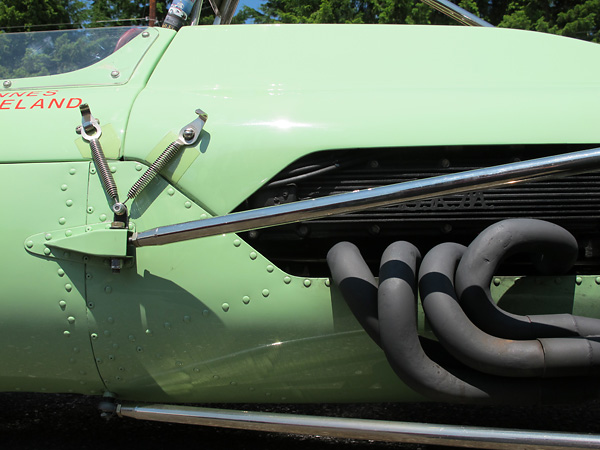
�
In lieu of a tubular steel frame, BRP created an elaborate fabrication of thin NS4-spec aluminum panels.
�
�
IMPORTANT ANNOUNCEMENT
�
BritishRaceCar.com will have to cut back plans for continued growth if we can't find more financial support.
�
If you like what you've found here, and you want to see more, please click here and follow the instructions.
�
Readers like you keep BritishRaceCar.com online and growing through voluntary financial contributions.
�
BRP-BRM Formula One Results
��
Charismatic and popular British driver Innes Ireland drove BRP-built racecars in five of ten 1963 Grand Prix�
championship races and seven of ten 1964 championship races, plus seven non-championship�
Formula One races. Throughout the 1963 season, Ireland's BRP teammate Jim Hall drove an older�
car: a BRM powered Lotus 24, but for 1964 Jim Hall moved on and was replaced by Trevor Taylor. Taylor�
was provided a second-generation BRP-BRP racecar, and he drove it in seven of the 1964 season's ten�
championship events plus four non-championship races.�
�
BRP's 1963 Grand Prix Championship Results ¹
�| Race / Venue | Date | Winning Car | Ireland's Result (in BRP-BRM) | Jim Hall's Result (in Lotus 24) | |
| 1 | Monaco Grand Prix | May 26 | BRM | (Lotus) retired, accident, Q5 | retired, gearbox, Q13 |
| 2 | Belgian Grand Prix (Spa) | June 9 | Lotus-Climax | retired, gearbox, Q7 | retired, accident, Q12 |
| 3 | Dutch Grand Prix (Zandvoort) | June 23 | Lotus-Climax | 4th, Q7 | 8th, Q18 |
| 4 | French Grand Prix (Reims) | June 30 | Lotus-Climax | 9th, Q9 | 11th, Q18 |
| 5 | British Grand Prix (Silverstone) | July 20 | Lotus-Climax | retired, ignition, Q11 | 6th, Q13 |
| 6 | German Grand Prix (Nürb.) | Aug.4 | Ferrari | retired, accident (1st lap), Q11 | 5th, Q16 |
| 7 | Italian Grand Prix (Monza) | Sept.8 | Lotus-Climax | 4th (engine failed at end) | 8th, Q17 |
| 8 | U.S. Grand Prix (Watkins Glen) | Oct.6 | BRM | withdrawn (injured) | 10th, Q10 |
| 9 | Mexican Grand Prix (Mex.City) | Oct.27 | Lotus-Climax | withdrawn (injured) | 8th, Q15 |
| 10 | South African Grand Prix (P.G.) | Dec.28 | Lotus-Climax | didn't participate | didn't participate |
| Final: | Lotus (Clark) | 9th in points | 13th in points |
�
BRP's 1964 Grand Prix Championship Results ²
�| Race / Venue | Date | Winning Car | Innes Ireland's Results | Trevor Taylor's Results | |
| 1 | Monaco Grand Prix | May 10 | BRM | DNS (accident in practice) | retired, fuel leak, Q14 |
| 2 | Dutch Grand Prix (Zandvoort) | May 24 | Lotus-Climax | didn't participate | didn't participate |
| 3 | Belgian Grand Prix (Spa) | June 14 | Lotus-Climax | 10th, Q16 | 7th, Q12 |
| 4 | French Grand Prix (Rouen) | June 24 | Lotus-Climax | retired, accident, Q11 | retired, accident, Q12 |
| 5 | British Grand Prix (Brands) | July 11 | Lotus-Climax | 10th, Q10 | (Lotus 24) retired, unwell, Q18 |
| 6 | German Grand Prix (Nürb.) | Aug.2 | Ferrari | didn't participate | didn't participate |
| 7 | Austrian Grand Prix (Zeltweg) | Aug.23 | Ferrari | 5th, Q11 | retired, suspension, Q16 |
| 8 | Italian Grand Prix (Monza) | Sept.6 | Ferrari | 5th, Q13 | DNQ |
| 9 | U.S. Grand Prix (Watkins Glen) | Oct.4 | BRM | retired, gearbox, Q10 | 6th, Q15 |
| 10 | Mexican Grand Prix (Mex.City) | Oct.24 | Brabham-Climax | 12th, Q16 | retired, overheating, Q18 |
| Final: | Ferrari (Surtees) | 14th in points | tied for 19th in points |
�
�
Podium finishes eluded the BRP team through the two championship seasons, but Innes Ireland did drive�
his BRP-BRM to victory in the opening race of the 1964 season, the Daily Mirror Trophy at Snetterton.³�
Except for Ferrari, all the top teams and most of the top drivers participated. Driving through heavy sleet and�
in snow, Ireland came from seventeenth place to take the checkered flag in a race that was flagged early due�
to inclement weather. Only thirty-five of the scheduled fifty laps were run. �
�
 �
�
�
�
Sorting Out the Various B.R.P. Formula One Racecars
��
The BRP team designed and constructed exactly three Formula One racecars, and all were built for the team's�
own use. No additional or spare monocoque tubs were built by BRP. The first car of the type, chassis number�
63/1, was built specifically for Innes Ireland to drive through the 1963 Formula One season. 63/1 featured a�
BRM B56 V8 engine and a Colloti Type 32 five speed gearbox, although BRP later updated it to a BRM�
six speed gearbox.�
�
BRP 63/1 still exists, sort of. After BRP was done with it, 63/1 passd to Alf Francis who in mid-1966 was�
employed by Scuderia Serenissima to develop a one-off Formula One entry which was to be powered by�
one of Giovanni Volpi's V8 engines. BRP 63/1's monocoque tub was used, though highly modified with�
entirely retrograde suspensions at both front and rear. Inboard front suspension was replaced with outboard.�
Independent rear suspension was replaced with a deDion set-up. Testing went badly. The resulting car�
unsuccessfully contested one Austrian hillclimb in 1970 before being retired. Photos and additional�
documentation of 63/1's reincarnation can be found here.�
�
For the 1964 Formula One season, the team built two additional BRP racecars: 64/2 was built for Innes Ireland�
and 64/3 built for Trevor Taylor. Both 64/2 and 64/3 were built with BRM B56 engines, mated to BRM's excellent�
six speed transaxles. �
�
�
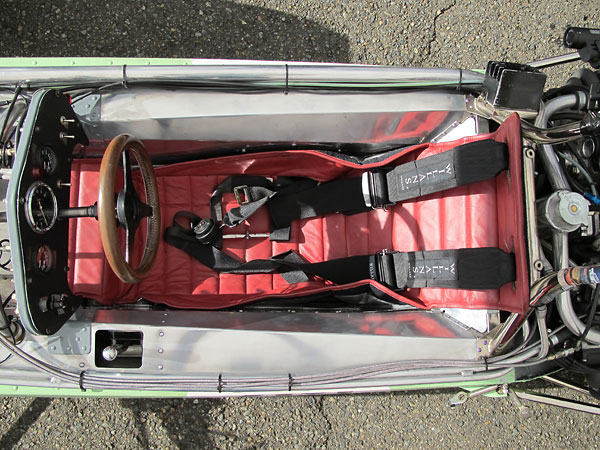
�
The three BRP-BRM racecars were built around distinctly different NS4 aluminum monocoque tubs. All
�
three featured a dual pontoon ("bathtub") layout with various thicknesses of aluminum. The pontoons
�
were generally D-shaped in cross section and about 12" tall by 6" wide, but their shape and dimensions
�
through the cockpit area varied in detail. 63/1 was 11.0" wide at the pedals, it tapered out to 16.50" wide
�
at the instrument panel, then it continued rearward with parallel sides along the driver's torso. 63/1's inner
�
panels were 16 gage and its outer skin was 18 gage. 64/2 and 64/3 were tailored to fit Innes Ireland and
�
Trevor Taylor respectively. Both of these cars were 9.5" wide at the pedals, tapered out to 13.5" wide, but
�
to suit Trevor Taylor's wider hips, 64/3 was widened approximately 1" on either side with inset pocketed
�
panels. To reduce weight on the 1964 cars, inner panels were 18 gage and the outer skin was 19 gage.
�
�
How else did 64/2 and 64/3 differ from the original BRP-BRM (63/1)? Firstly, Tony Robinson redesigned�
front and rear suspensions to utilize lower, wider wheels and tires. Except for the four suspension uprights,�
Lotus 24 spare parts were no longer suitable, instead BRP specially designed and fabricated their own parts�
or else at least procured parts from other sources. They were now a constructor in their own right. A detailed�
look at the BRP design can be found below.�
�
After its original Grand Prix career, BRP chassis number 64/2 passed to John Willment Automobiles, who�
entered it in one Formula One race in the 1966 season. This was of course after Formula One rules changed�
to permit larger engines, so Tony Robinson was hired to install a Climax 3.0L V8 engine. At the International�
Gold Cup, held on 17 September 1966 at Oulton Park, John Campbell-Jones qualified tenth, but was black�
flagged due to an oil leak. �
�
BRP 64/2 reappeared again in 1969 after conversion to Formula 5000 specification with a Ford 4798cc V8�
engine and a Colotti-Francis gearbox. Amateur British driver Kaye Griffiths entered his BRP in the final six�
rounds of the inaugural British Formula 5000 season, then transported the car to New Zealand where he�
entered the first three rounds of the 1970 Tasman Series.4�
After a broken rear upright caused a wheel to come off during qualifying for the car's third Tasman Series�
appearance, Griffiths sold 64/2 to local New Zealand driver Peter Hughes, who repaired it and entered one�
additional Tasman Series race before putting the car into storage, where it suffered severely from neglect.�
�
In 1985 the well known New Zealand fabricator and constructor Ferris de Joux, assisted by ex-McLaren mechanic�
Peter Bruin (of Goodwood Engineering in Auckland), restored 64/2 using the few remaining original parts�
found by a friend of Ferris on the back of a truck heading for the scrapyard. Ferris explained: "When I got the�
original tub it was just $150 worth of rubbish with the nose cone broken off a few inches ahead of the front bulkhead,�
no roll over bar, pedals, radiator, or brackets, or engine mounts. We pulled it apart and used it for patterns. The centre�
bulkhead, radius rod mounts, dashboard and frame, mounts for the rear leg of the bottom front wishbone, outer skins�
for the front section of the tub, and the front suspension rockers were the only usable parts. Peter made the front bulkhead.�
It was very expensive. I cut out the rear bulkhead and Peter welded it." Later, Ferris wrote: "The engine (block, at least)�
was one of BRP's as was the gearbox (62/9)5, dash panel, outer skin, center�
bulkhead, dash frame, front rockers, and suspension brackets. I built the inner skin, engine cover, and the front half of�
the nose cone."�
�
While building a new monocoque tub and incorporating in it a few reusable components mentioned above�
(e.g. center bulkhead, outer skins for the front section, etc.), Ferris de Joux also built an additional tub to the same�
pattern. This second tub was originally assembled with a Ford 'Kent' four cylinder engine and a Hewland transaxle, but�
they've been removed. Allen McGregor of Scotland bought the two de Joux racecars (i.e. the restored 64/2 and�
the replica made from it) and campaigned them in the UK. Rob Fowler of Hall&Hall was hired to rebuild the�
replica to a far more representative specification (e.g. BRM 1.5L engine, stroked to 2.0L, and BRM six speed transaxle,�
as seen here). Microsoft President Kurt DelBene subsequently bought the cars. The more-original Innes Ireland�
1964 season car (chassis 64/2) retains a 1.5L BRM engine, and makes occasional racing appearances in England�
and Europe. Its livery is identical to the replica shown here, except that it wears racing number 9 instead of number 41.�
This replica is kept in Redmond, Washington and makes occasional appearances at North American events.�
�
What happened to the third of the three original BRP-BRM racecars? Stirling Moss Auto Racing Team retained 64/3 and�
entered it in the 1966 South African Grand Prix with Richie Ginther driving. Ginther spun out the car and was�
broadsided by Jo Bonnier (in a Rob Walker Lotus-Climax.) The resulting damage meant BRP 64/3's racing days were�
over, but it was returned to England and sold to Jim Russell. Russell had a contract to supply cars for John�
Frankenheimer's classic movie "Grand Prix" (circa 1966). For that use, 64/3 was modified by former Lotus racing�
mechanic Ted Woodley. According to some reports, it was fitted with an early (non crossflow) Ford Kent engine�
and a Hewland transaxle. There are conflicting reports about 64/3's precise role(s) in the movie. After filming,�
whatever remained of 64/3 was scrapped. �
�
Features and Specifications (as currently presented)
�| Engine: | �BRM "B56" 1.5L V8 engine, stroked to 2.0L�
Dual overhead camshafts (i.e. two per cylinder bank), gear driven.�
Single plane crankshaft.�
Lucas mechanical fuel injection (Mk1 8-cylinder).�
Lucas 3SC transistorized electronic ignition (disable. �
A late model Lucas ignition box is hidden under the seat, with a rev limiter.)�
Belden spark plug wires.�
Dry sump lubrication system. | �
| Cooling: | �aluminum radiator with integral (side-by-side) engine oil cooler. | �
| Exhaust: | �bespoke sand-bent four-into-one headers. | �
| Transaxle: | �BRM 6-speed transmission, without reverse. � Clutch type limited slip differential.� Roller bearing / universal jointed half shafts. | �
| Front Susp.: | �dual wishbone front suspension.�
Coilover KONI model 8212 double adjustable shock absorbers actuated through (upper) rocker arms.�
Lotus magnesium front uprights (part number 1988).�
Non-adjustable anti-sway bar.�
Track = 52.5". | �
| Rear Susp.: | �inverted lower wishbones, single top links, and twin radius arms.�
Lotus Type 18 (F1) through 21 magnesium rear uprights (part number 8318-2.)�
Coilover KONI model 8212 double adjustable shock absorbers.�
Non-adjustable anti-sway bar.�
Track = 55.0". (Wheelbase = 91.0".) | �
| Brakes: | �(master) dual Girling master cylinders with adjustable bias bar. � (front) Girling AR brake calipers and 10.5" solid rotors. � (rear) Girling AR brake calipers and 9.5" solid rotors. | �
| Wheels/Tires: | �reproduction Lotus "wobbly web" style six-lug front wheels.�
H&H four-lug rear wheels.�
Dunlop Racing 5.50-L13 CR65 MkII (front) and 7.00-L15 CR65 (rear) tires. | �
| Electrical: | �alternator.�
Odyssey Extreme Racing 30 battery (part number 9750M6746, AGM, 20.0lb, 450CCA).�
Ark Racing lightweight gear reduction starter motor. | �
| Instruments: | �(left to right)�
Racetech dual fuel pressure (0-160psi) and coolant temperature (30-120C) gauge,�
Smiths tachometer (0-12,500rpm),�
and Racetech dual oil pressure (0-160psi) and oil temperature gauge (30-120C).�
| �
| Fuel System: | �two new fuel bags, with combined capacity of 14 gallon.�
Facet low pressure electric fuel pump.�
Bosch high pressure electric fuel pump.�
FueLab 535-series fuel pressure regulator.�
Lucas fuel injection metering unit. | �
| Safety Eqmt: | �Willans six point cam-lock safety harness.�
RaceTech quick release steering wheel hub.�
Lifeline Zero 2000 centralized fire suppression system. | �
| Racing Class: | �1.5L Formula One (except with a Tasman Series spec engine.�
(In other words, a longer stroke crankshaft has been installed�
to increase displacement to ~2.0L.) | �
Engine Installation
��

�
The BRM "B56" 1.5L V8 engine was first introduced in October 1961.
�
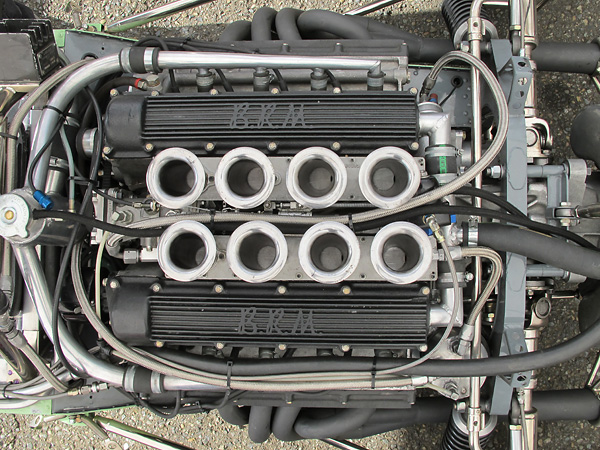
�
In Formula One trim, its 68.5mm bore and 50.5mm stroke combined for a displacement of 1498cc.
�
The BRM B56 engine was rated 205hp at 11,000rpm. Of course, performance varied by installation.
�

�
The BRM engine's camshafts were gear driven. Rival Climax V8s used chain-driven camshafts.
�
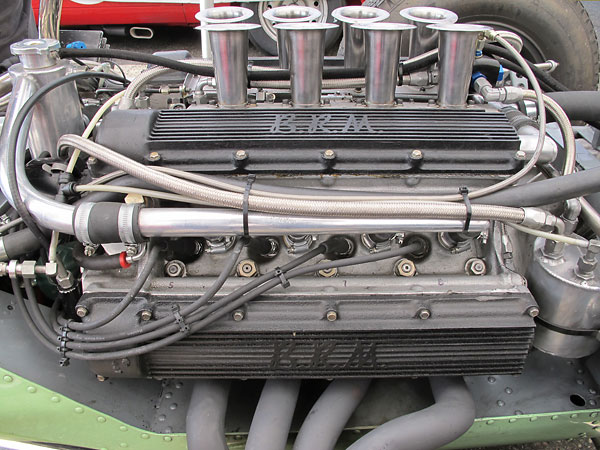
�
The BRM engine also featured a single plane crank. Climax started with dual-plane cranks on their V8s,
�
but switched and used single plane cranks from ~September 1964. One major advantage of a dual-plane
�
crankshaft is that its better balanced, which can improve engine durability and reduce bearing wear.
�
Single plane cranks use a different firing order, and that firing order simplifies exhaust optimization.
�

�
Hand-crafted, sand-bent, four-into-one exhaust headers.
�
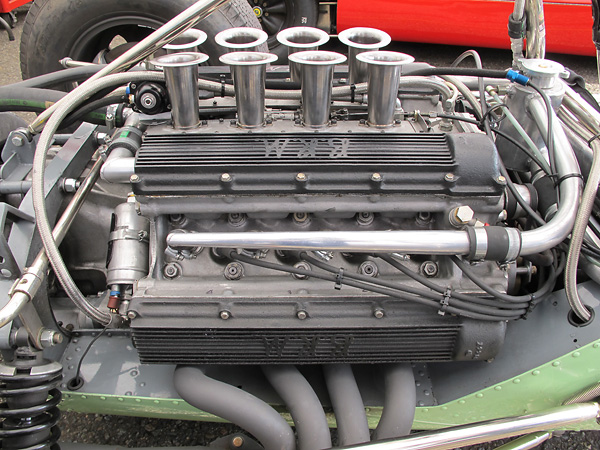
�
BRM offered various differently configured cylinder heads for these engines. For example, the BRM
�
works team chose center-exhaust cylinder heads for their 1964 BRM P261 racecars. In other words,
�
their exhaust ports exited into the engine's valley, and intake ports were routed between camshafts.
�
Tony Robinson: "BRM team personel were very helpful to work with, but Innes, Masten, and
�
Trevor often complained that our engines lacked the performance of the works cars."
�
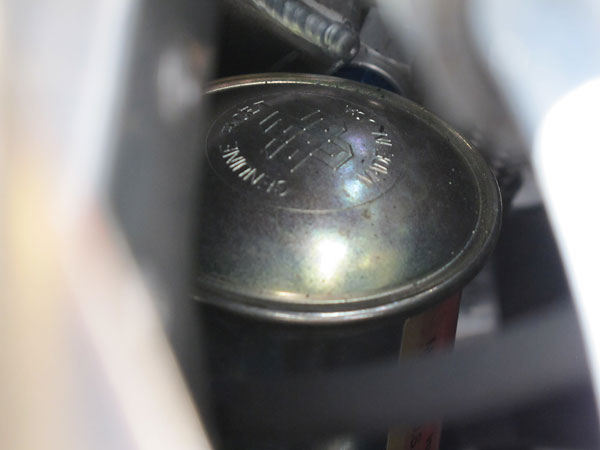
�
A Facet (Bendix type) low pressure electric fuel pump fills an intermediary tank.
�

�
This is the intermediary "make up" fuel tank.
�
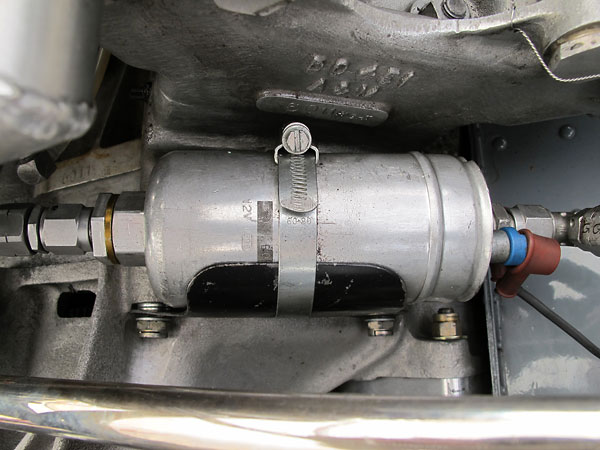
�
This is a relatively modern Bosch high-pressure electric fuel pump, but it is installed in
�
the same position as the original Lucas fuel pump. The Lucas fuel pumps used by BRP
�
and some of their contemporaries were commonly referred to as "bombs." That's a
�
pretty clear hint why they're better suited for car museums than for vintage racing.
�
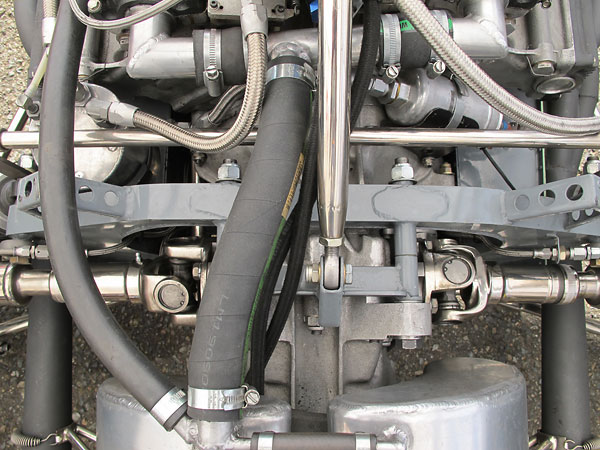
�
The Lucas pumps were tall, and on the BRP-BRM their size necessitated a hole right
�
through the top of the engine cover. The hole is missing on this car, but does exist
�
on the sister car. These BRP-BRMs have never used engine-driven fuel pumps.
�
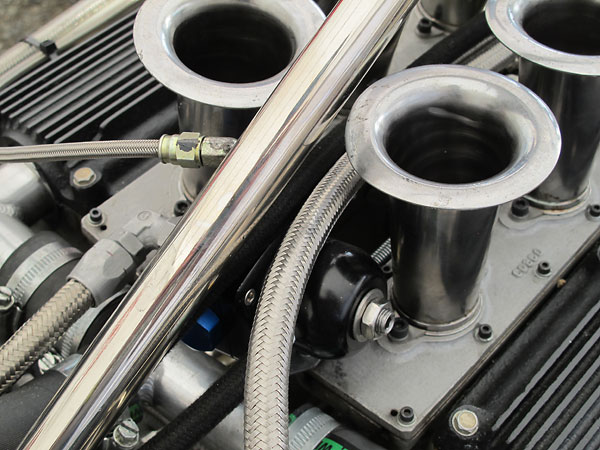
�
Modern FueLab 535-series adjustable fuel pressure regulator (in situ).
�

�
The high pressure fuel pump can deliver as much as 120 psi whereas the Lucas reciprocating
�
shuttle fuel metering and distribution system requires about 100psi. This adjustable
�
fuel pressure regulator restricts the high end, for more consistent performance.
�
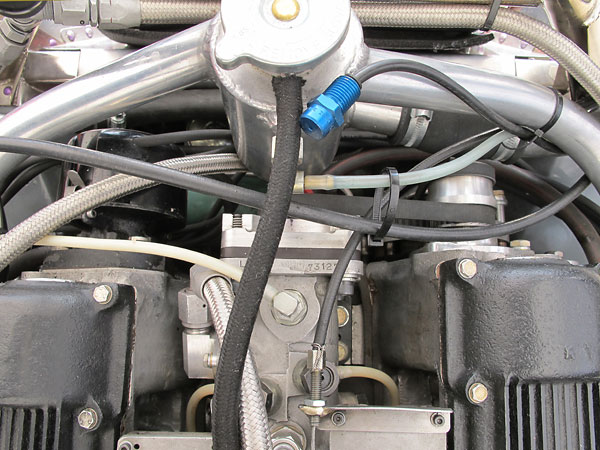
�
This is the period correct Lucas mechanical fuel injection metering unit. BRP could easily
�
compare carburetion and fuel injection in 1963 because they ran carbs on Jim Hall's Lotus-BRM
�
through mid season. Hall reported a big torque improvement after upgrading to fuel injection.
�

�
This Lucas metering unit is stamped: L1897 73127A 5175.
�
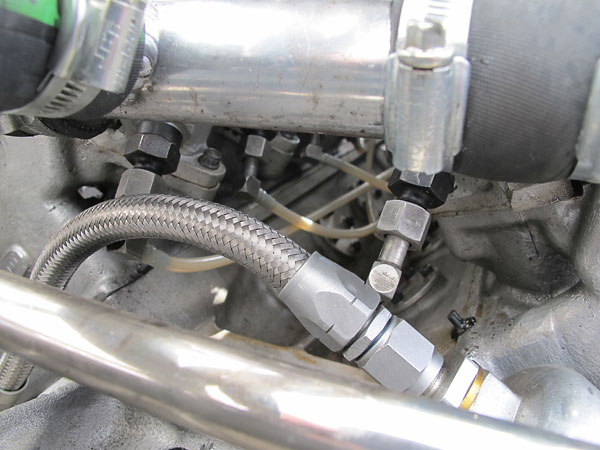
�
Fuel is injected through simple jets, mounted just downstream of the throttle slides.
�

�
The Lucas transistorized (electronic) ignition system was introduced simultaneously on the BRM V8 and
�
also on the rival Coventry Climax V8. BRP mounted their Lucas transistorized ignition modules outside
�
where airflow would help keep them cool. The Lotus team mounted theirs in the V of the Climax engine,
�
vulnerable to failure due to overheating.
�
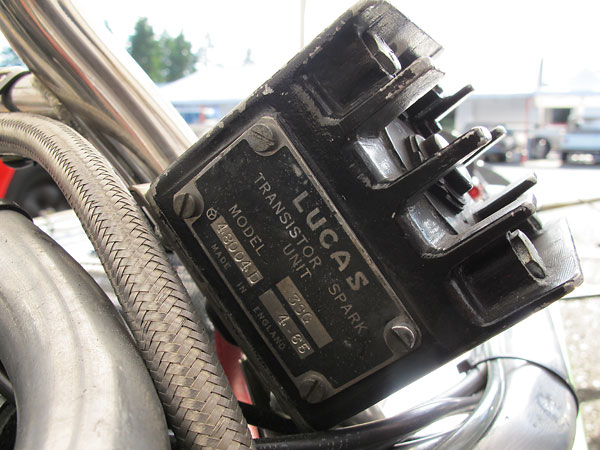
�
Lucas Transistor Spark Unit / Model 3SC, Serial No. 48004D, Date Code: 4-65 / Made in England.
�
The Lucas ignition system provided a tremendous high RPM performance improvement over any
�
breaker point based system and it was also more effective than the magneto ignition systems
�
available at the time. The issue is one of precision: for best performance, spark plugs must fire at
�
exactly the right time relative to the compression cycle, and without variation between cylinders.
�

�
The trigger mechanism employed four magnetic pole pieces mounted on a camshaft-driven flywheel.
�
It's a simple system: without any sort of "advance" mechanism as would be required for a street car.
�
In other words, spark plugs were timed to fire at 33 degrees before maximum compression (i.e. piston
�
"top dead center" position) - always - without consideration of engine RPM or load. This was suitable
�
for engines that typically ran at 11,000rpm whenever they were on track. At less than 6000rpm, the
�
engines certainly didn't run well, and they were a bear to start or drive through the paddock. For this
�
reason, for vintage racing the original electronics are actually disconnected and a more modern
�
electronic ignition module has been hooked-up underneath the driver's backrest.
�
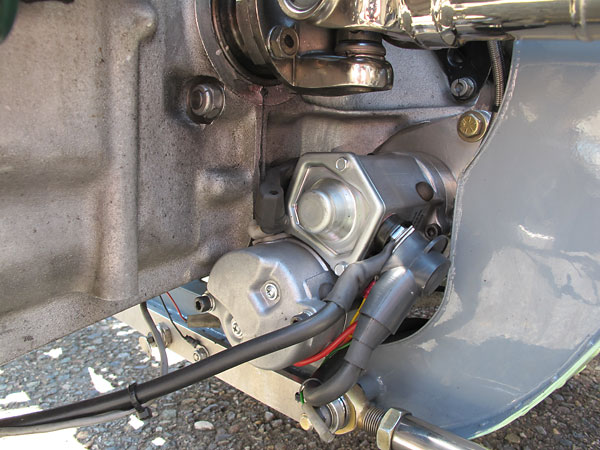
�
Ark Racing lightweight gear reduction starter motor.
�
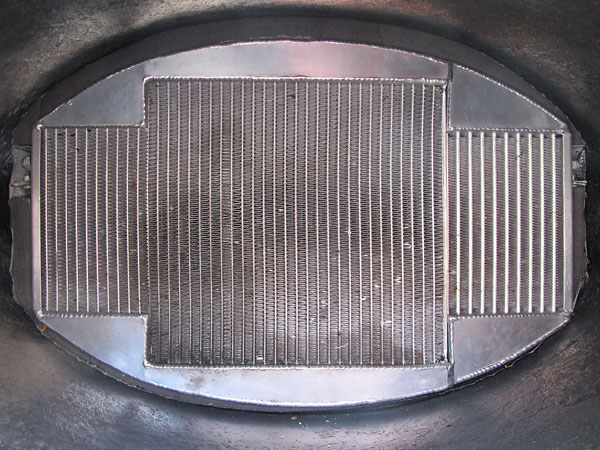
�
Aluminum radiator with integral oil cooler. (In this view, the oil cooler is on the righthand side.)
�
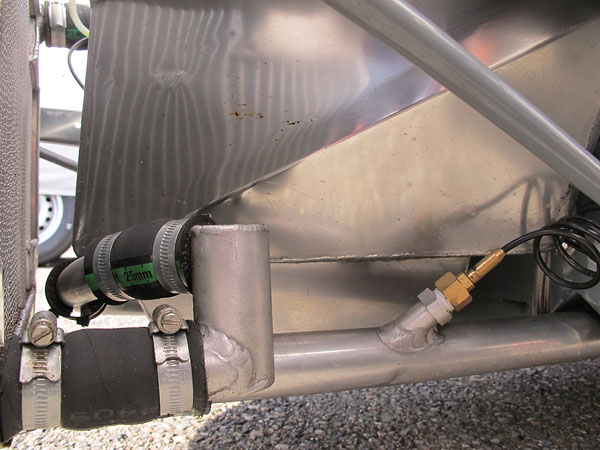
�
Coolant and oil return lines route underneath the chassis rather than through it.
�
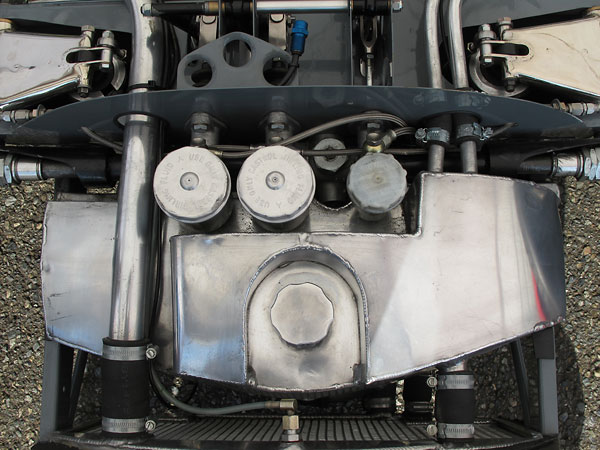
�
The engine is dry sumped, and its oil is stored in this large aluminum tank..
�
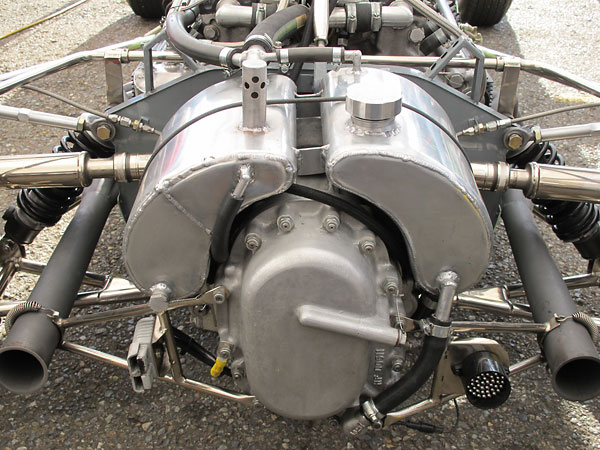
�
Left: crankcase breather/overflow tank. Right: oil reservoir for the transaxle, which is dry sumped.
�
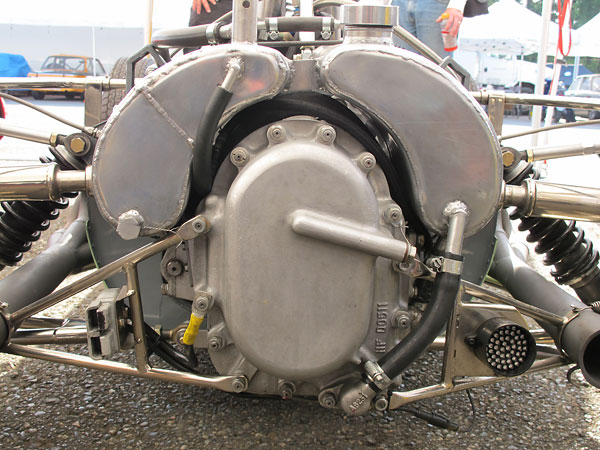
�
No rule required 1.5L Formula One cars to have a reverse gear, so the BRM transmission didn't have one.
�
It did have an early limited slip differential, although not a very good one by modern standards.
�
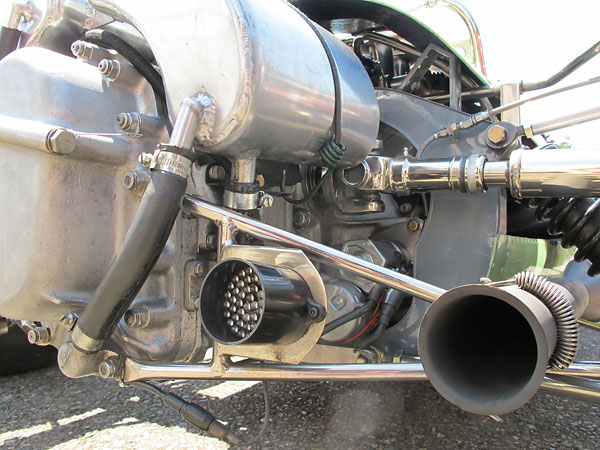
�
A rain light is required for vintage racing. This one features light emitting diodes.
�
�
Front Suspension
��
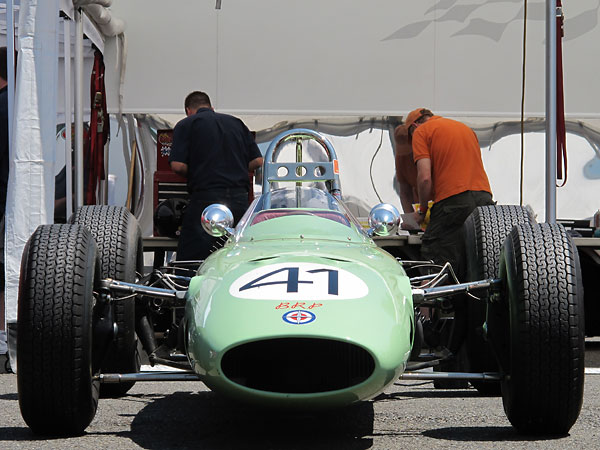
�
BRP initially carried over the familiar Lotus 24 front suspension to their own chassis. Then, BRP
�
worked to develop the car to suit wider and lower wheel and tire sizes as they became available.
�
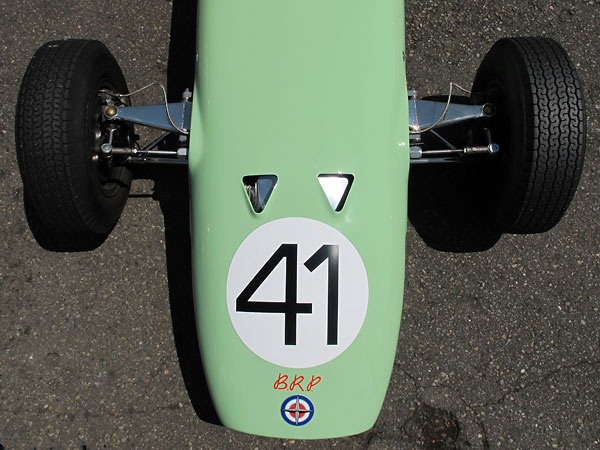
�
Dunlop was the dominant supplier of Formula One tires through this car's era, and they continuously
�
improved their product. Compound and manufacturing changes improved grip and durability, while
�
sidewall height was coming down and tread width was getting wider. The L-section tires this car wears
�
for vintage racing hold it back from dramatically quicker lap times it could achieve with different tires.
�
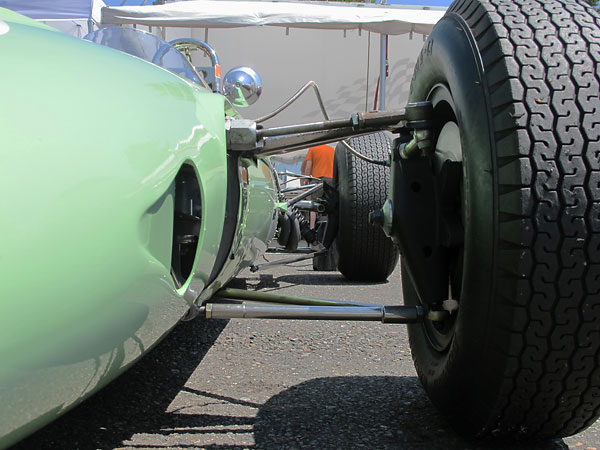
�
Inboard front suspension and front brakes tucked neatly into wheel cavities: Formula One designers
�
hadn't yet begun to seek aerodynamic downforce, but by 1963 they were quite good at streamlining.
�

�
Shock absorbers, springs, and the anti-sway bar are all actuated by rocker arms.
�
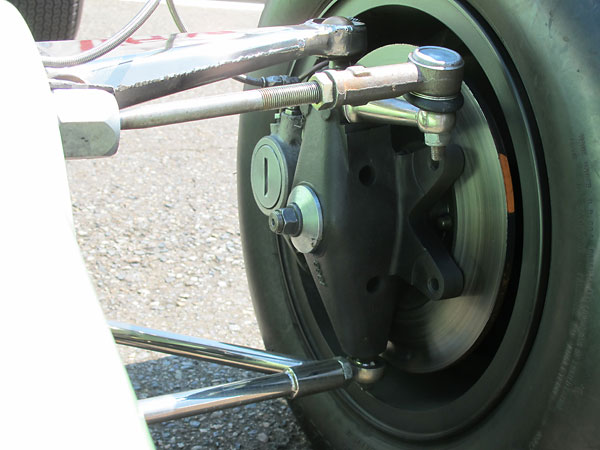
�
Lotus Elektron (magnesium alloy) front uprights, part number 1988.
�
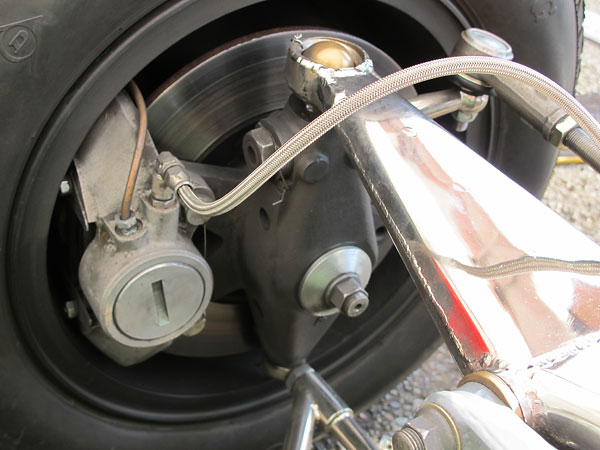
�
Girling AR brake caliper and solid 10.5" rotor.
�
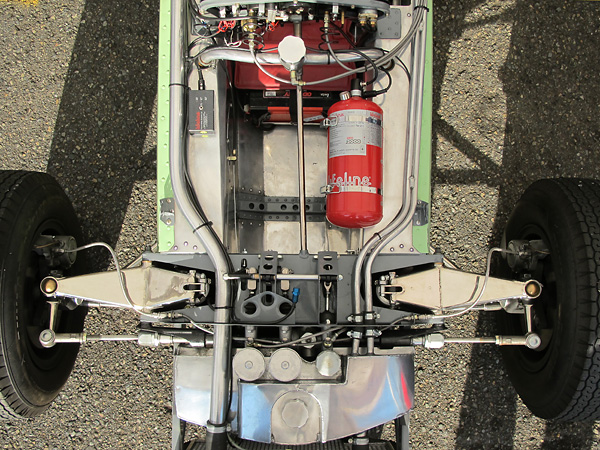
�
This early bathtub-style monocoque chassis could have been stiffer if its designers had taken simple
�
steps to brace across the large openings of its top, but it must have seemed incredibly stout in its day.
�

�
BRP didn't make their own steering racks. Instead, they used a Lotus rack on the first racecar (63/1)
�
and BRM steering racks on the last two (64/2 and 64/3).
�
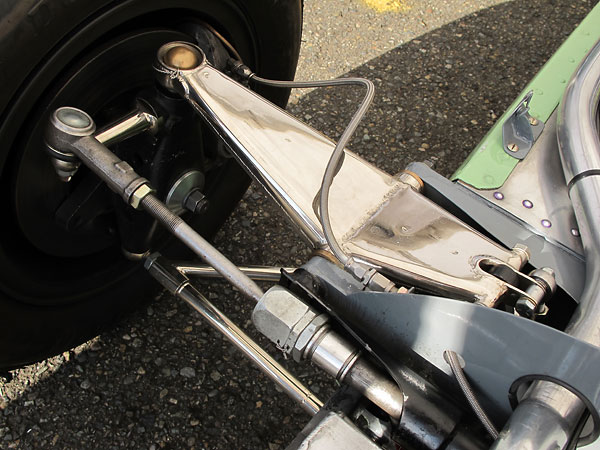
�
The front anti-sway bar is non-adjustable, difficult to swap out, and impossible to see in this photo.
�
However, you can see the Heim joint and part of the link which connect it to the righthand rocker arm.
�
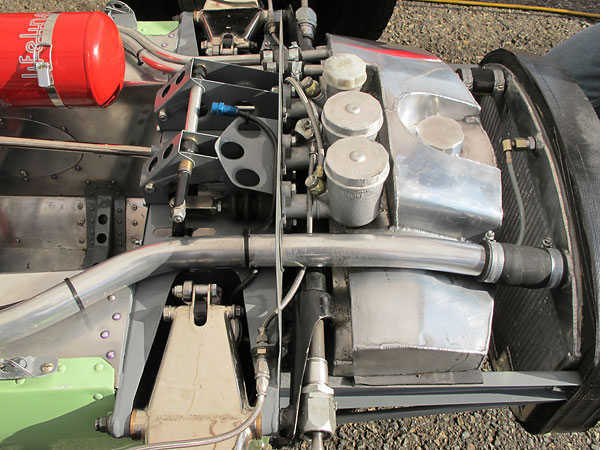
�
Girling brake and clutch master cylinders with integral reservoirs.
�
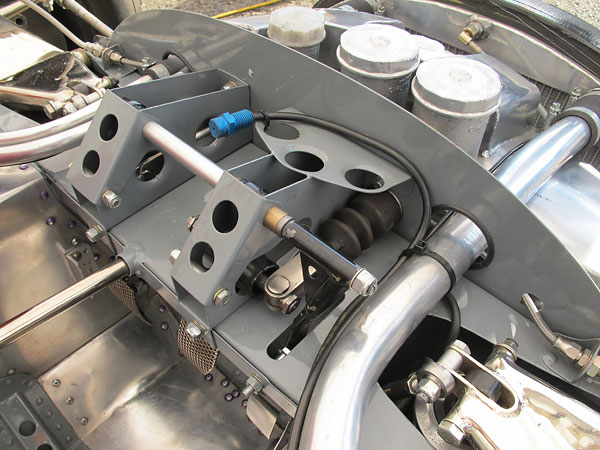
�
A lot of fabrication work went into elimination of flexing at the pedals and master cylinder mountings.
�
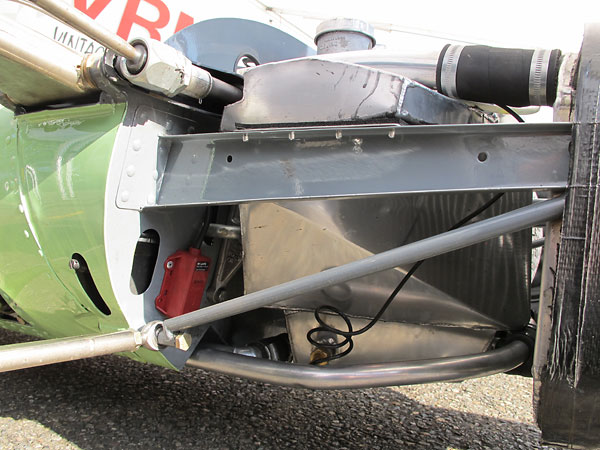
�
The red plastic device at left is a transponder, which is part of a modern timing/scoring system.
�
To the left of that are two holes in the tub through which shock adjustments can just barely be made.
�
Below the transponder, we see one of two V-section longitudinal channels for routing plumbing.
�
This is also the best photo we have of the structure that supports the radiator and oil reservoir.
�
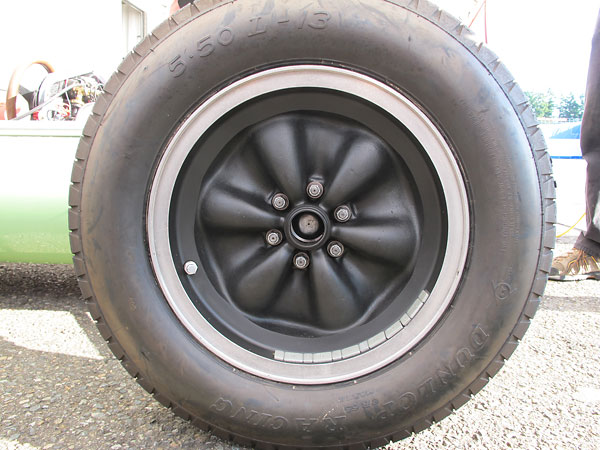
�
Dunlop center-lock wheels were on BRP-BRM 63/1 when it arrived at Spa for its first race in 1963 but
�
were swapped out with Lotus wobbly web magnesium wheels for the race, and from then on BRP
�
used Lotus wheels through 1963. (15x6.0 at the front and 15x7.0 at the rear.)
�
�
Enjoying this article? www.BritishRaceCar.com is partially funded through generous support from readers like you!
�
To contribute to our operating budget, please click here and follow the instructions.
�
(Suggested contribution is twenty bucks per year. Feel free to give more!)�
Rear Suspension
��
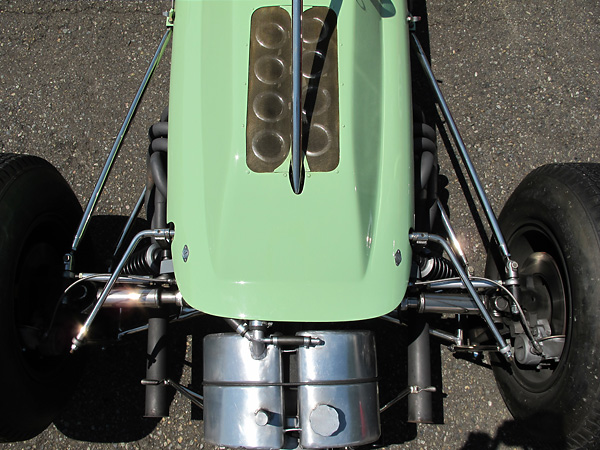
�
Inverted lower wishbones, single top links, and twin radius arms.
�
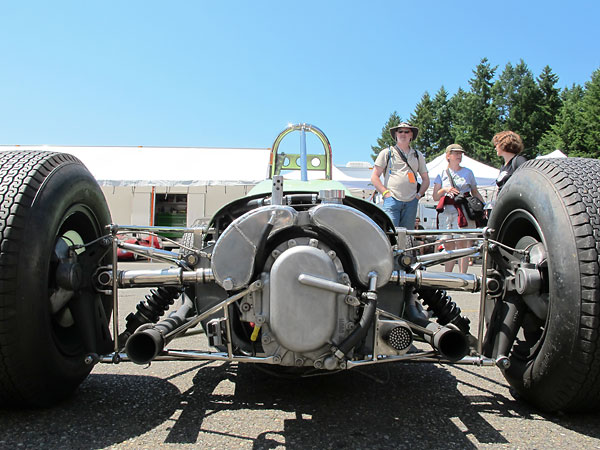
�
These were small cars. Rear track was just 55.0" and wheelbase was only 91.0".
�
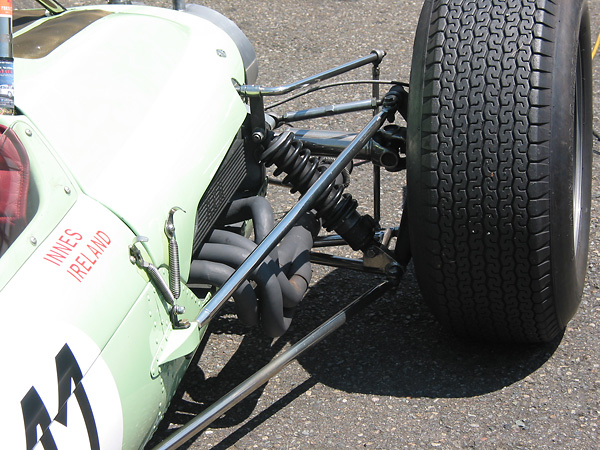
�
On the Lotus 24, rear shock absorbers had been mounted behind the halfshafts. On the Lotus 25
�
and the BRP-BRM, the rear shock absorbers are located forward of the halfshafts.
�

�
On the BRP, the BRM engine block is a stressed member.
�
It contributes significantly to chassis strength and stiffness.
�

�
Safety wire, because things could get ugly if this bolt came loose.
�
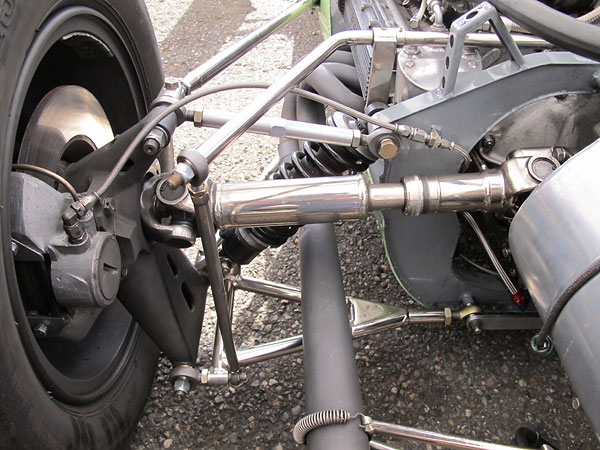
�
Roller bearings in the half shafts accomodate plunge.
�
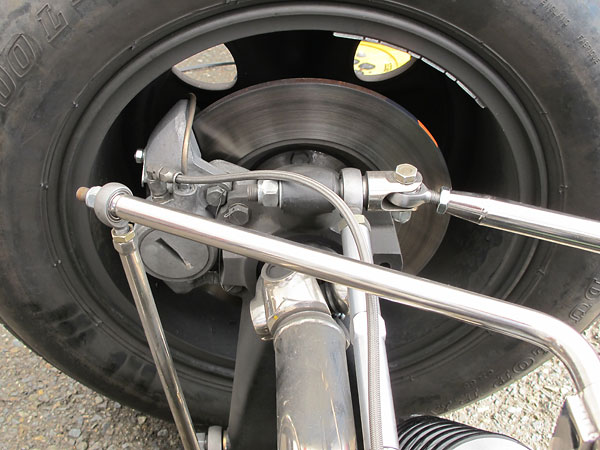
�
Non-adjustable rear anti-sway bar.
�
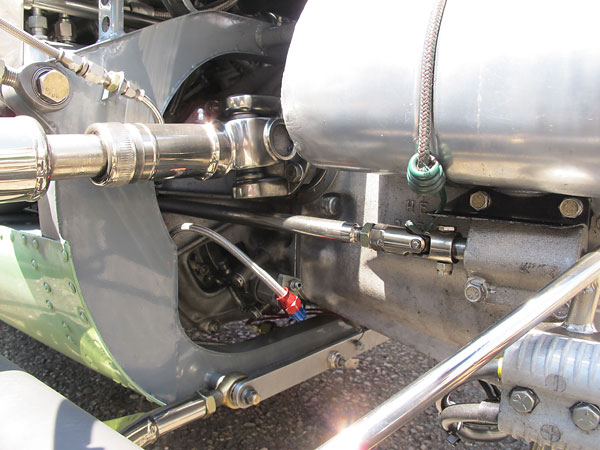
�
Rear bulkhead, shifter linkage, and clutch slave cylinder details. Notice that someone has added
�
an aluminum bar between the lower control arm mounts. This is a sensible and elegant design
�
refinement, but it doesn't appear in any old photographs of the car we've studied.
�
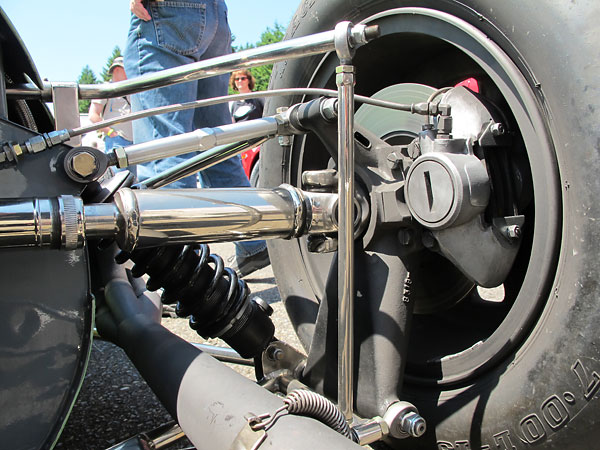
�
Lotus Type 18 through 21 magnesium rear uprights, part number 8318-2.
�
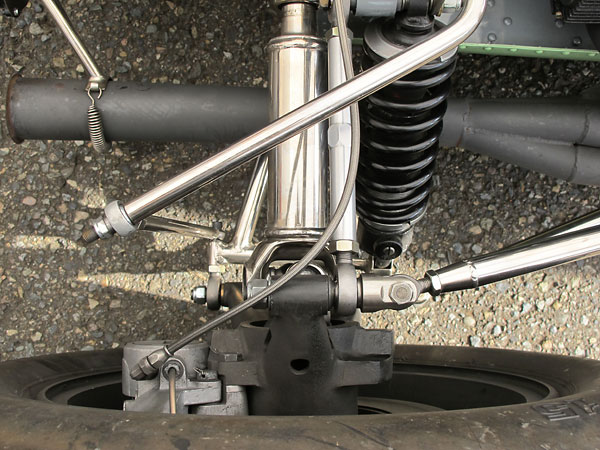
�
Coilover KONI model 8212 double adjustable shock absorber (not original).
�

�
Girling aluminum racing brake caliper. This is the AR size. Girling made larger versions called
�
BR and CR respectively. They also made a somewhat smaller version which was called NR.
�

�
Temperature indicating paint on the edge of the brake rotor changes color when it gets hot.
�
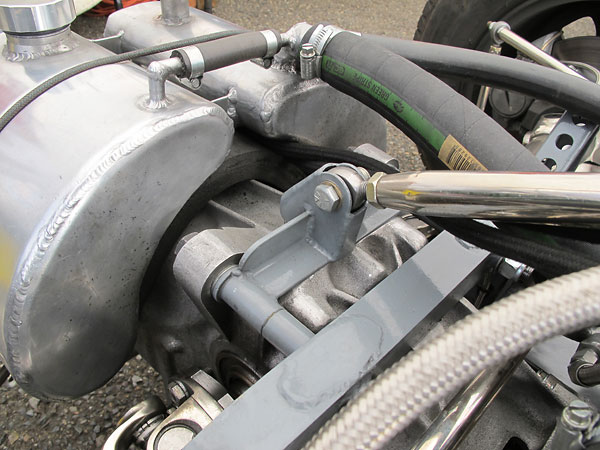
�
The rearward roll hoop brace is modern, and pains have been taken to make its installation "reversible."
�

�
A detailed look at the rear bulkhead, from above.
�
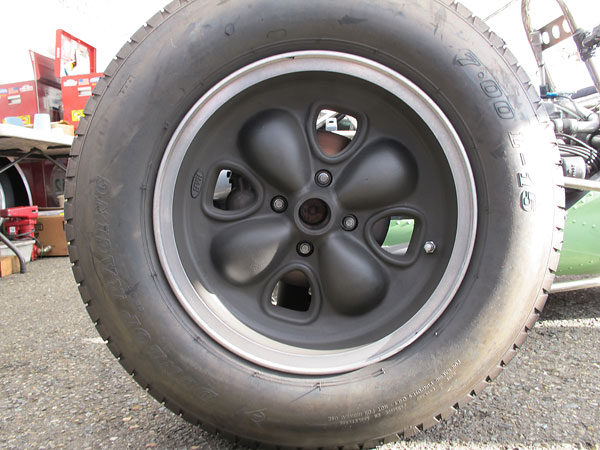
�
The most important technical change BRP made for 1964 was the switch to wider, smaller diameter
�
tires. This wasn't a simple swap because suspension geometry had to be altered significantly, and
�
of course new wheels were required. BRP used Lotus six-stud 13x7.0 front wheels, but appropriate
�
Lotus wheels for the rear weren't available so instead they used Brabham four stud 13x8.5 wheels.
�
(The currently-installed wheels don't accurately represent what BRP used in either 1963 or 1964.)
�
�
Interior
��
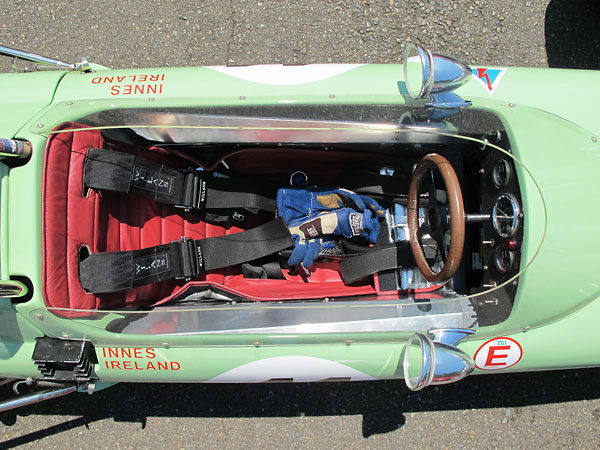
�
The cozy cockpit of the BRP-BRM Formula One racecar.
�

�
Leather covered steering wheel.
�
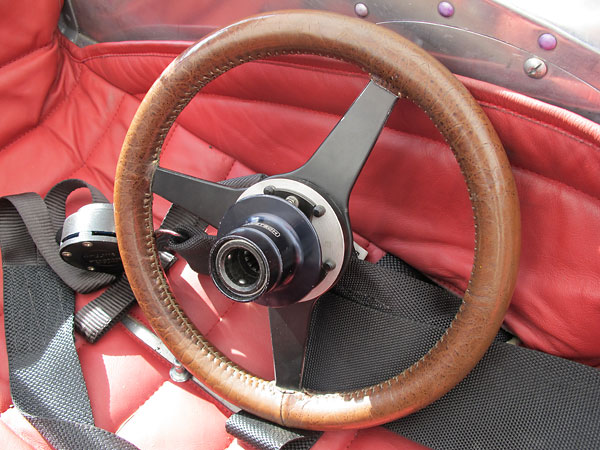
�
This RaceTech quick release steering wheel hub is a modern era innovation, and an important
�
safety feature. Before it was installed, getting into or out of the car was a contortionist's act.
�
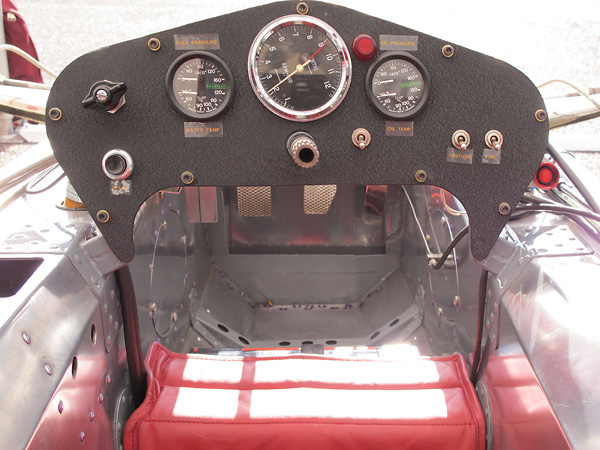
�
Left to right: Racetech dual fuel pressure (0-160psi) / coolant temperature (30-120C) gauge, Smiths
�
tachometer (0-12500rpm), and Racetech dual oil pressure (0-160psi) / oil temperature gauge (30-120C).
�

�
Odyssey Extreme Racing 30 battery (part number 9750M6746, AGM, 20.0lb, 450CCA).
�
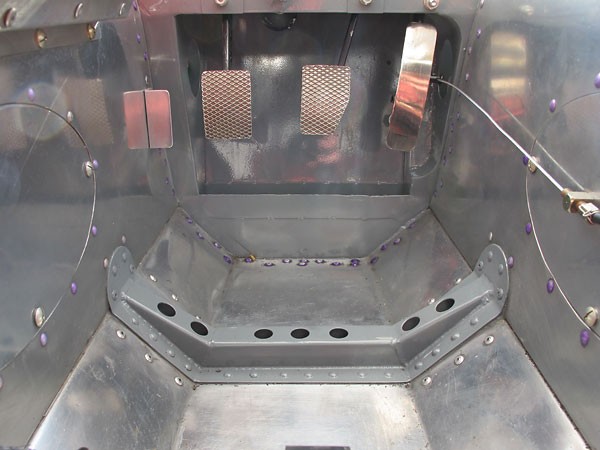
�
A stiff steel brace helps transfer suspension loads across the floor panel. Although the tub's
�
main panels are aluminum, bulkheads and baffles and brackets were mainly fabricated from
�
18 and 19 gage mild steel
�
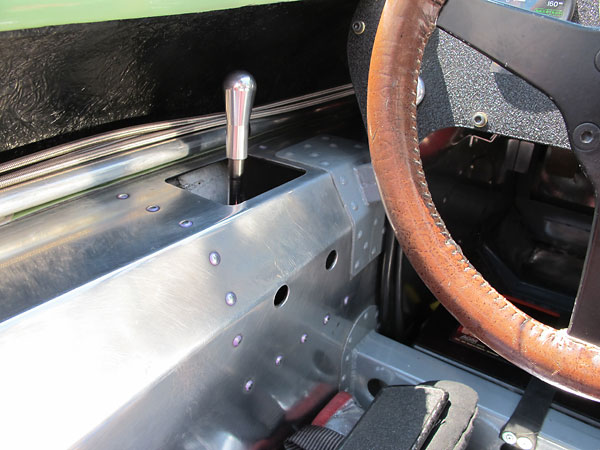
�
Six speeds forward selected from a double-H pattern, but no reverse gear.
�
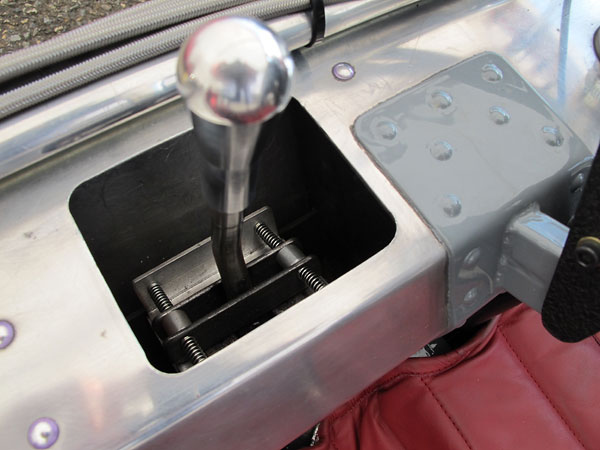
�
Number 9 car has a shifter plate whereas number 41 doesn't, but they have identical levers and knobs.
�

�
Willans six point cam-lock safety harness.
�
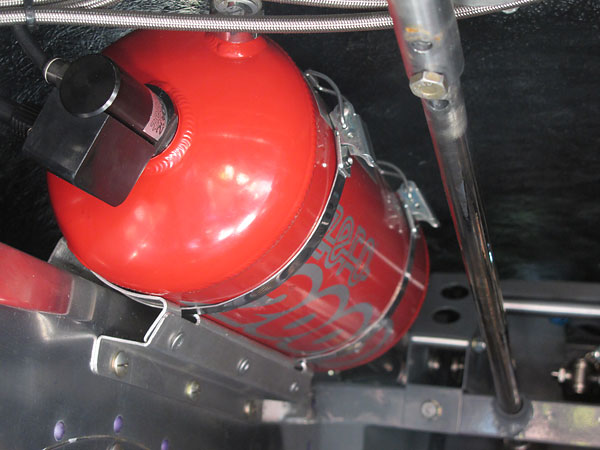
�
Lifeline Zero 2000 centralized fire suppression system.
�
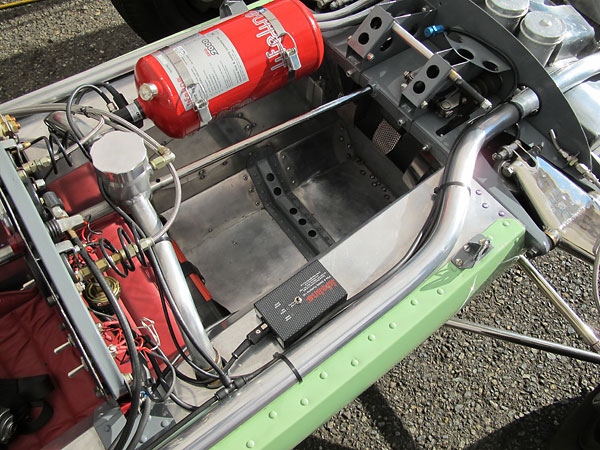
�
The fuel filler is only accessible for refueling when fiberglass bodywork is removed for access.
�
Foreground: electronic control module for the Lifeline fire suppression system.
�
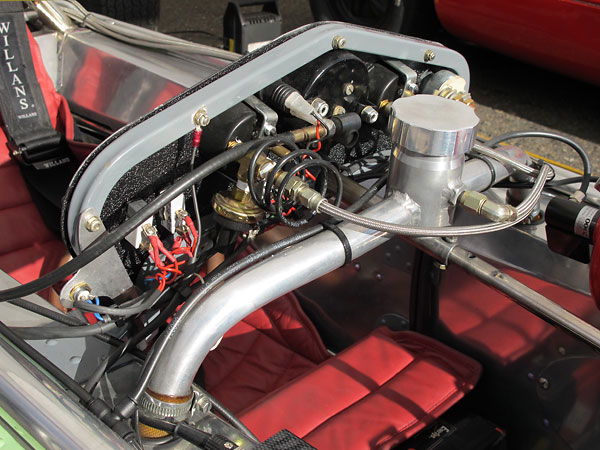
�
The BRP-BRMs were originally built with three Maston-Excelsior rubber fuel bladders - two in the
�
pontoons plus a 4.5 gallon cell under the seat - for a combined capacity of ~27.5 gallons. As
�
prepared for vintage racing, smaller dual fuel bladders provide this car a capacity of ~14 gallons.
�
Fuel economy? These cars burn about six gallons per half hour session.
�

�
A late model Lucas electronic ignition box is now hidden under the seat, along with a rev limiter.
�
There's also some fuel plumbing, and access to the oil filter.
�

�
Modern tall roll hoop with formed sheetmetal headrest bar and rearward brace. (The original
�
BRP-BRM racecars had lower hoops with tubular crossbraces, and no rearward braces.)
�
�
Exterior
��
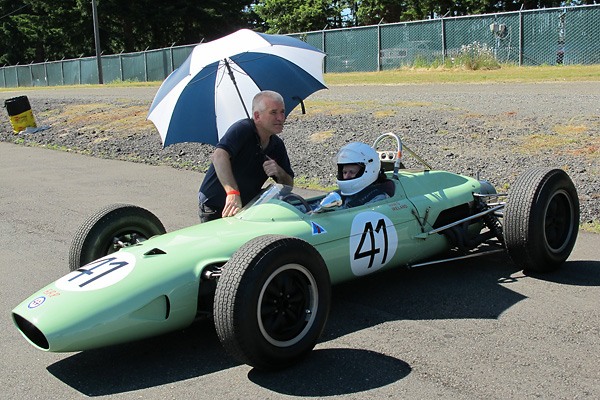
�
Byron Sanborn holds an umbrella for Kurt DelBene as the pre-grid fills.
�
(at the 2011 Pacific Northwest Historics, Pacific Raceways in Kent, Washington.)
�

�
The BRP-BRM was the second car of Formula One's new generation to feature monocoque
�
construction. That it was developed so quickly and proved both reliable and quick right out of
�
the box is a tremendous credit to the small, well coordinated team which pulled together to build it.
�
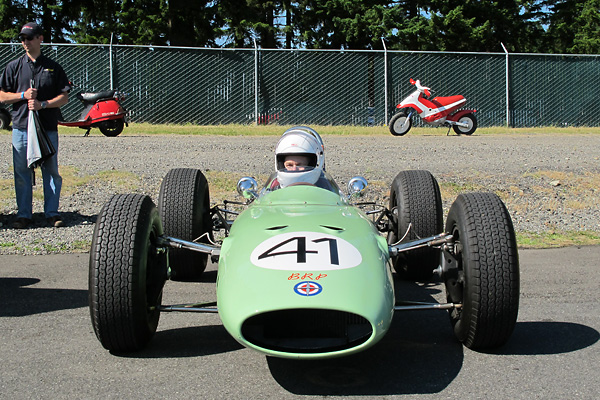
�
In the BRP-BRM's era, the entire Formula One field ran on Dunlop R6 tires. In 1963, R6s had
�
a taller aspect ratio than they did in 1964. Racing on L-section tires, 1.5L F1 cars had less
�
grip than even late sixties era Formula Fords.
�
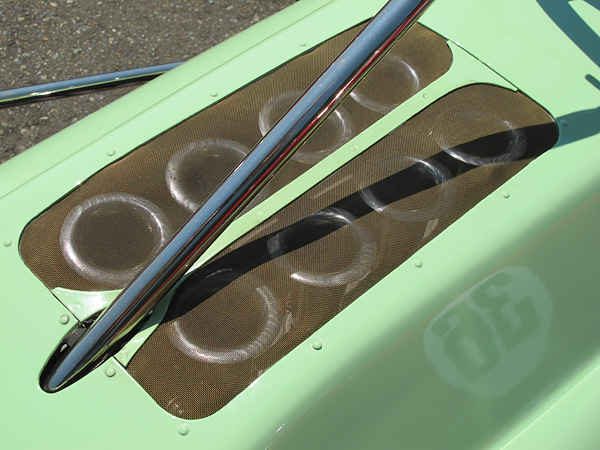
�
Easiest way to tell a BRP-BRM from a Lotus 25 at high speed? The velocity stacks on the BRP
�
fitt neatly under the engine cover. The Lotus, with its Climax engine, used taller stacks.
�
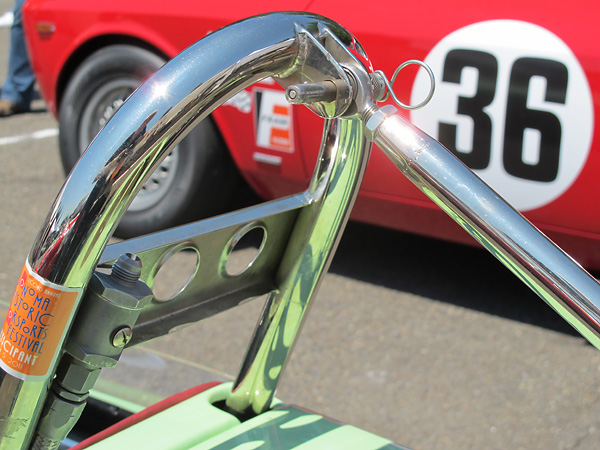
�
British Racing Partnership's team cars were some of the most recognizeable of their era because of
�
their distinctive "meadow green" paint color. The color was selected by team co-owner Alfred Moss.
�

�
Alfred Moss (Stirling's dad) had been a racing driver in his own right. His first notable victory was in
�
the Private Competitors' Handicap race during the 1923 Easter meeting at Brooklands. His car was a
�
Sporting Crouch powered by an Anzani four cylinder engine. In it, he averaged about 65mph. Just
�
one year later he managed to secure a seat for the Indianapolis 500, where he piloted one of three
�
Barber-Warnock sponsored racecars for Louis Chevrolet's team to a 16th place finish at 84mph.
�
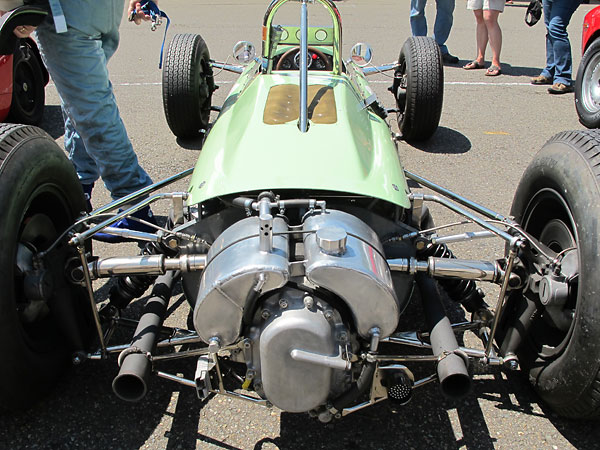
�
BRP's departure from Grand Prix racing was assured in 1964 when the team was blackballed by Lotus
�
Ferrari, and ultimately BRM in their attempt to join the Formula One Constructors Association. Although
�
Cooper and Brabham supported BRP's bid for membership, the other three member companies blocked
�
BRP's application on grounds that they weren't producing enough of the car's they raced. Membership in
�
FOCA had become hugely important that year because the organization had used its collective leverage
�
to negotiate new starting money agreements with the various race organizers. For non-members,
�
starting money dropped to a level that made BRP's continued participation far less attractive.
�
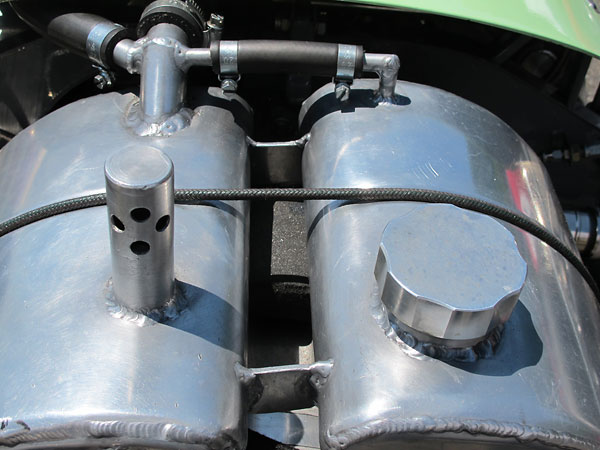
�
After leaving Formula One, British Racing Partnership accepted a commission to design and build
�
two final cars... for the Indianapolis 500! The commission came from George R. Bryant, stepfather of
�
driver Masten Gregory. BRP's Indy project started in February 1965 and the resulting two cars were
�
delivered to Indianapolis in early May. Tony Robinson deserves full credit for their design; fabrication
�
was assisted by Jim Chapman, George Woodward, Stan Collier, Bruce McIntosh and Peter Downie.
�
At Indy, Howard Gilbert & George Salih installed Ford quad cam engines and ZF 5DS-25 transaxles.
�
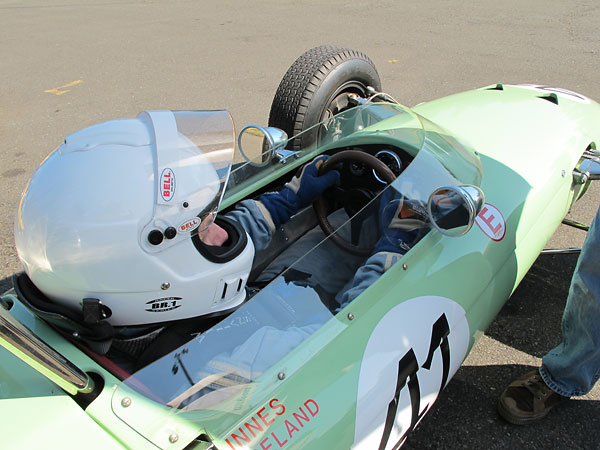
�
The BRP Indy cars proved competitive over a long three-year career. Poor luck in qualifying set the
�
stage for an exciting 1965 race: Masten Gregory started 31st of 33 in car number 41 (serial 65/1). From
�
the back of the pack, Gregory drove brilliantly and climbed to fourth place before a loss of oil pressure
�
on lap 59 of 200 forced him to retire for a 23rd-place finish. Johnny Boyd started 29th and completed
�
140 laps before a gearbox failure forced him to retire for a 13th-place finish. Two years later at the 1967
�
Indy 500, Carl Williams started the number 41 car from 23rd position, yet worked his way up through
�
the field and was running third on the race's final lap when he got tied up in an accident. Conclusion:
�
BRP didn't design or build many racecars, but their expertise in these disciplines was considerable.
�
| Notes: | |||||||||||||||||||||||||||||||||||||||||||||||||||||||||||||||||||||||||||||||||||||||||||||||||||||||||||||||||||||||||||||||||||||||||||||||||||||||||||||||||||
| (1) | �
In 1963, Jim Clark won the Formula One championship easily with his Climax V8 powered Lotus 25.�
In addition to the ten race championship season, there were fourteen non-championship F1 races in 1963.�
When BRP's drivers entered these races, they used the team's Lotus 24s, with just one notable exception.�
Innes Ireland drove his BRP-BRM at the Solitude Grand Prix near Stuttgart on July 28. He finished third.�
� | ||||||||||||||||||||||||||||||||||||||||||||||||||||||||||||||||||||||||||||||||||||||||||||||||||||||||||||||||||||||||||||||||||||||||||||||||||||||||||||||||||
| (2) | �
In 1964, John Surtees won the Formula One championship by just one point with his V8 powered Ferrari.�
In addition to the ten race championship season, there were also eight non-championship�
F1 races in 1964 and BRP contested six of these.�
Ireland won the first one! It was the Daily Mirror Trophy at Snetterton.�
Ireland had an accident in the second one: the News of the World Trophy at Goodwood.�
Ireland and Taylor both retired their BRPs early at the Aintree 200,�
Ireland with a suspension failure and Taylor with an engine problem.�
Ireland had a bad accident at Silverstone in the BRDC International Trophy race, and Taylor retired with low oil pressure.�
Ireland also had an accident at Solitude.�
Ireland finished third in the Mediterranean Grand Prix at Sicily, but Taylor suffered a suspension trailing link failure.�
(In two other non-championship F1 races, Taylor drove the team's leftover Lotus 24.)�
� | ||||||||||||||||||||||||||||||||||||||||||||||||||||||||||||||||||||||||||||||||||||||||||||||||||||||||||||||||||||||||||||||||||||||||||||||||||||||||||||||||||
| (3) | �
The BRP-BRM's One Victory� Daily Mirror Trophy, Snetterton, 14 March 1964�
� | ||||||||||||||||||||||||||||||||||||||||||||||||||||||||||||||||||||||||||||||||||||||||||||||||||||||||||||||||||||||||||||||||||||||||||||||||||||||||||||||||||
| (4) | �
BRP-BRM 64/2 Results after being Rebuilt for Formula 5000� Guards F5000 Championship:�
� The Tasman Series: �
�  � Kaye Griffiths' attempt to qualify for the 19th Lady Wigram Trophy race comes to an abrupt end. � (Photographer unknown. This photo appeared in Shell Oil's "1970 New Zealand Motor Racing".) � � | ||||||||||||||||||||||||||||||||||||||||||||||||||||||||||||||||||||||||||||||||||||||||||||||||||||||||||||||||||||||||||||||||||||||||||||||||||||||||||||||||||
| (5) | �
It isn't clear exactly how or when chassis 64/2 was re-united with BRM rengine or transaxle as described�
by Ferris de Joux. Both he and Peter Bruin have passed away, so we were unable to check that detail. �
� | ||||||||||||||||||||||||||||||||||||||||||||||||||||||||||||||||||||||||||||||||||||||||||||||||||||||||||||||||||||||||||||||||||||||||||||||||||||||||||||||||||
�
�
We wish to gratefully acknowledge all the people who provided information and assistance with this article,�
including especially Ken Gregory and Tony Robinson who gave interviews and also Byron Sanborn of Vintage�
Racing Motors of Redmond Washington who walked us around the car and helped us understand what we�
were looking at. Thor Thorson of Vintage Racing Motors and racing writer/biographer Ian Wagstaff were also�
extremely generous with their assistance. �
�
Unless otherwise noted, all photos shown here are from June 2011 when we viewed the car at�
The Pacific Northwest Historics at Pacific Raceways in Kent, Washington.�
All photos by Curtis Jacobson for BritishRaceCar.com,�
copyright 2011. All rights reserved.
�
| If you liked this article, you'll probably also enjoy these: | �|||||
 | �
Jay Nadelson 1957 Cooper T43 | �
 | �
Marcus Jones 1960 Lotus 18 Junior | �
 | �
Eric Haga 1970 Lola T190 | �
| You're invited to discuss anything you've seen here on The British Racecar Motorsports Forum! | �|||||
�
Notice: all the articles and almost all the photos on BritishRacecar.com are by Curtis Jacobson.
�
(Photos that aren't by Curtis are explicitly credited.) Reproduction without prior written permission is prohibited.
�
Contact us to purchase images or reproduction permission. Higher resolution images are optionally available.
�

 �
�